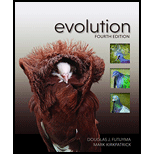
Concept explainers
To distinguish: Between the rate of
Introduction: Diversity is defined as the number of species or genera in many evolutionary studies. Analysis of changes in diversity can be done by studying paleontology and by the phylogenetic relationship among the species. Changes in speciation and diversification can be studied using a number of taxa (N). Speciation rate is represented as S while diversification rate is represented as D.
Explanation of Solution
The differences between the rate of speciation and diversification rate are mentioned as follows:
| No. | Character | Rate of Speciation | Rate of Diversification |
| 1. | Definition | Speciation rate refers to the probability of one species “giving birth” to another species over a short period of time represented as dt. | Diversification rate is defined as the average increase or decrease in diversity per taxon. |
| 2. | Representation | Speciation rate is represented by S. | D is used to represent the rate of diversification. |
| 3. | Calculation | Rate of speciation can be calculated by dividing the change in the number of species per unit time. | Subtracting speciation rate from extinction rate gives the rate of diversification. |
To explain: The relationship between the rate of speciation, a number of species and the rate of diversification.
Introduction: Diversity is defined as the number of species or genera in many evolutionary studies. Speciation rate refers to the probability of one species “giving birth” to another species over a short period of time which is represented as dt. Diversification rate is defined as the average increase or decrease in diversity per taxon.
Explanation of Solution
Subtracting speciation rate from extinction rate gives a rate of diversification represented as D. Speciation rate would be greater than the extinction rate if the value of D is greater than 1. A decline in the number of species would be observed if the value of D is negative. There will be an exponential increase or decrease in the number of species if the value of D remains constant over a period of time.
Want to see more full solutions like this?
Chapter 19 Solutions
Evolution, Fourth Edition (looseleaf)
- 22. Which of the following mutant proteins is expected to have a dominant negative effect when over- expressed in normal cells? a. mutant PI3-kinase that lacks the SH2 domain but retains the kinase function b. mutant Grb2 protein that cannot bind to RTK c. mutant RTK that lacks the extracellular domain d. mutant PDK that has the PH domain but lost the kinase function e. all of the abovearrow_forwardWhat is the label ?arrow_forwardCan you described the image? Can you explain the question as well their answer and how to get to an answer to an problem like this?arrow_forward
- Describe the principle of homeostasis.arrow_forwardExplain how the hormones of the glands listed below travel around the body to target organs and tissues : Pituitary gland Hypothalamus Thyroid Parathyroid Adrenal Pineal Pancreas(islets of langerhans) Gonads (testes and ovaries) Placentaarrow_forwardWhat are the functions of the hormones produced in the glands listed below: Pituitary gland Hypothalamus Thyroid Parathyroid Adrenal Pineal Pancreas(islets of langerhans) Gonads (testes and ovaries) Placentaarrow_forward
 Biology (MindTap Course List)BiologyISBN:9781337392938Author:Eldra Solomon, Charles Martin, Diana W. Martin, Linda R. BergPublisher:Cengage Learning
Biology (MindTap Course List)BiologyISBN:9781337392938Author:Eldra Solomon, Charles Martin, Diana W. Martin, Linda R. BergPublisher:Cengage Learning Concepts of BiologyBiologyISBN:9781938168116Author:Samantha Fowler, Rebecca Roush, James WisePublisher:OpenStax College
Concepts of BiologyBiologyISBN:9781938168116Author:Samantha Fowler, Rebecca Roush, James WisePublisher:OpenStax College Biology: The Dynamic Science (MindTap Course List)BiologyISBN:9781305389892Author:Peter J. Russell, Paul E. Hertz, Beverly McMillanPublisher:Cengage Learning
Biology: The Dynamic Science (MindTap Course List)BiologyISBN:9781305389892Author:Peter J. Russell, Paul E. Hertz, Beverly McMillanPublisher:Cengage Learning Biology 2eBiologyISBN:9781947172517Author:Matthew Douglas, Jung Choi, Mary Ann ClarkPublisher:OpenStax
Biology 2eBiologyISBN:9781947172517Author:Matthew Douglas, Jung Choi, Mary Ann ClarkPublisher:OpenStax Human Biology (MindTap Course List)BiologyISBN:9781305112100Author:Cecie Starr, Beverly McMillanPublisher:Cengage Learning
Human Biology (MindTap Course List)BiologyISBN:9781305112100Author:Cecie Starr, Beverly McMillanPublisher:Cengage Learning





